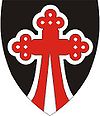Halliste
| Halliste | |||
|
|||
| State : |
|
||
| Circle : |
|
||
| Coordinates : | 58 ° 10 ′ N , 25 ° 26 ′ E | ||
| Area : | 266.4 km² | ||
| Residents : | 1,697 (2010) | ||
| Population density : | 6 inhabitants per km² | ||
| Time zone : | EET (UTC + 2) | ||
| Telephone code : | (+372) 243 | ||
| Community type: | former rural community | ||
| Website : | |||

|
|||
Halliste is a former rural community in the Estonian district of Viljandi with an area of 266.4 km². It had 1697 inhabitants (as of January 1, 2010). On October 24, 2017, the rural parishes of Karksi, Abja , Halliste and the small town of Mõisaküla were merged to form the new rural municipality Mulgi .
In addition to the main town Halliste (365 inhabitants), the rural community included the villages Ereste, Hõbemäe, Kaarli, Kalvre, Kulla, Maru, Mulgi, Mõõnaste, Naistevalla, Niguli, Õisu , Pornuse (German: Alt-Bornhusen), Päidre, Päigiste, Raja, Rimmu, Saksakülla, Sammaste, Tilla, Toosi, Ülemõisa, Uue-Kariste (German: Neu-Karrishof), Vabamatsi and Vana-Kariste (German: Alt-Karrishof).
Halliste was mentioned in a document under the name Allistekunde as early as 1211 in the chronicle of Heinrich of Latvia . Particularly worth seeing is the church consecrated to Saint Anne , the previous wooden building of which was built between 1504 and 1508. Today's sacred building dates from 1867. The ( neo-Romanesque ) style still shows parts of the previous buildings. The altar painting is by the modern Estonian artist Jüri Arrak .
The historic Halliste cemetery was laid out in 1776.
Web links
- Halliste municipality website (Estonian)
- Halliste Church (Estonian)
- Parish Hallist in the Pernau district

